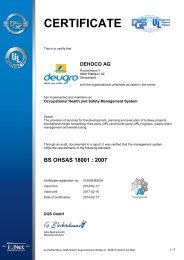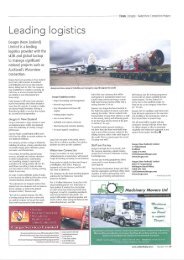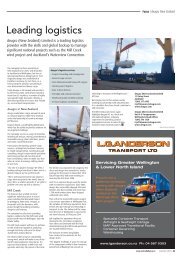CASES
You also want an ePaper? Increase the reach of your titles
YUMPU automatically turns print PDFs into web optimized ePapers that Google loves.
Five years in the planning. One new airport - and 88 cargo<br />
flights in 103 days delivering 6,000 tons. Thanks to an<br />
outstanding team of partners, in 2014 the world’s second<br />
largest natural gas deposits in the Southern Highlands and<br />
Western Provinces of Papua New Guinea will begin the first<br />
gas supplies to consumers in Asia.<br />
<strong>CASES</strong>
TUDY<br />
This is the story of how logistics,<br />
infrastructure and gas production<br />
and processing specialists came<br />
together to turn an ambitious project<br />
plan into a reality.
cargosuper market<br />
CASE STUDY<br />
WITH TEAMWORK,<br />
ANYTHING IS<br />
POSSIBLE<br />
Finding natural oil and gas<br />
energy reserves is challenging<br />
enough but extracting them<br />
can be even more complex and<br />
capital intensive and leaves no<br />
margin for error.<br />
Increasingly, the world’s leading energy<br />
corporations have to target more remote<br />
regions of the planet to develop new<br />
processing and pumping facilities. The<br />
risks are high but so too are the rewards<br />
and economic benefits for both industry<br />
and national and local economies.<br />
In Papua New Guinea, the discovery of<br />
natural gas deposits in its Hela, Southern<br />
Highlands and Western Provinces<br />
offered the potential to increase the<br />
country’s GDP. ExxonMobil PNG Limited,<br />
the operator of the PNG LNG Project,<br />
estimates that over the life of the gas<br />
production and processing project, over<br />
nine trillion cubic feet of gas will be<br />
produced and sold. The company began<br />
construction of the Project in 2010 and<br />
the first LNG will be exported in the<br />
second half of 2014.<br />
But first there was a major<br />
logistics challenge.<br />
Building a gas conditioning plant in<br />
the Highlands of Papua New Guinea<br />
was not going to be easy. The region<br />
is predominantly rugged mountainous<br />
terrain and conditions are made more<br />
challenging by the 9,000mm of rainfall in<br />
the area throughout the year.<br />
Logistically the biggest challenge was to<br />
deliver equipment and materials from<br />
the ports of Lae and Port Moresby to<br />
the Hides Gas Conditioning Plant, which<br />
is located in the Southern Highlands of<br />
Papua New Guinea at an elevation of over<br />
1500m. A large percentage of the 800kms<br />
of road from Lae are dirt tracks with<br />
gradients of over 20% and there are 99<br />
bridge crossings on the route as well. The<br />
maximum gross vehicle weight on a lot<br />
of the bridges is limited to 60,000kg, so<br />
with prime mover and trailer weights the<br />
maximum cargo weight via road was low<br />
by industry standards at around 25,000<br />
kilos. Additionally, the road between<br />
Lae and Hides has been subject to road<br />
closures due to landslides, washouts and<br />
other uncontrollable factors.<br />
Over 7,000 loads have already travelled<br />
this route. However, the Hides plant<br />
also required a lot of large, delicate<br />
and sensitive equipment in order to<br />
commence operation and the poor quality<br />
roads and restrictions between Lae and<br />
the jobsite were deemed not suitable<br />
to transport these materials. Another<br />
transport solution was clearly required.<br />
ExxonMobil recognised that to overcome<br />
these challenges would require an<br />
innovative logistics solution – and a lot of<br />
‘thinking outside of the box’.
PNG LNG PROJECT<br />
cargosuper market<br />
‘For us, it was not just a commercial project but the chance to test ourselves again’<br />
ExxonMobil contracted Volga-Dnepr<br />
Airlines, the world’s largest transporter<br />
of outsize and heavyweight air cargo,<br />
which over more than 20 years had<br />
demonstrated its unique ability to ‘make<br />
the impossible possible’.<br />
When teams of specialists from<br />
ExxonMobil and Volga-Dnepr first<br />
got together in 2008 to discuss the<br />
project, one question dominated the<br />
conversation: was it theoretically possible<br />
to fly thousands of tonnes of large, heavy,<br />
complex and sensitive equipment into<br />
the remote Highlands of Papua New<br />
Guinea to enable the building of a gas<br />
conditioning plant?<br />
The combined expertise and knowledge<br />
of the two organisations established that<br />
undertaking such a complex air logistics<br />
task was indeed possible – but first they<br />
had to build an airport.<br />
For Volga-Dnepr, working on projects<br />
some years in advance of performing<br />
an actual flight operation is part and<br />
parcel of its unique place in the world<br />
of aviation. The size and design of big<br />
pieces of high value industrial equipment,<br />
aircraft components and space satellites<br />
are often based on their ability to fit<br />
into the airline’s fleet of giant Antonov<br />
An-124 freighters because major global<br />
corporations recognise the vital role<br />
Volga-Dnepr plays in their supply chain.<br />
In the first phase of their cooperation, a<br />
joint team from ExxonMobil and Volga-<br />
Dnepr travelled to Papua New Guinea<br />
to evaluate four proposed locations<br />
for a new Highlands airport. This was<br />
subsequently reduced to two sites<br />
following inspections and, ultimately, one<br />
location in Komo based on Volga-Dnepr’s<br />
study of load lists and route options.<br />
Back in the UK, members of ExxonMobil’s<br />
PNG LNG Project team met with the<br />
airline to plan how many An-124 flights<br />
would be required, which routes would<br />
be used, the frequency of operations,<br />
the length of the project and flight<br />
programme, and the costs involved.<br />
In 2010, work began on the new<br />
Komo Airfield.<br />
To be able to handle An-124 freighter<br />
operations would require building Papua<br />
New Guinea’s longest paved runway at<br />
3,200m in length and 45m wide. Once<br />
complete the new airport would be able<br />
continued on page 12
cargosuper market<br />
CASE STUDY<br />
‘deugro and Volga-Dnepr Airlines<br />
were brought together early on in<br />
the project in putting together a<br />
unique trailer loading and<br />
off-loading concept to reduce<br />
the overall ground handling<br />
times for the aircraft’<br />
continued from page 11<br />
to welcome the world’s largest seriesproduced<br />
cargo aircraft with its 73 metre<br />
wingspan, maximum take-off weight of<br />
392 tons and payload of up to 120 tonnes.<br />
It would feed construction equipment<br />
and materials virtually to the door of the<br />
gas processing site through a series of<br />
90-minute flights from Port Moresby.<br />
The Soviet-built An-124 makes light<br />
work of logistics projects well beyond the<br />
capability of other commercial airliners.<br />
In terms of cargo handling, the aircraft is<br />
virtually self sufficient. Craneless loading<br />
and offloading technology saves hours<br />
and eliminates any additional costs arising<br />
from the need for third party handling<br />
equipment. In this case, reducing the time<br />
the aircraft needed to spend on the ground<br />
was essential to the one-flight-per-day<br />
schedule set for the project.<br />
Another key partner in the Hides project<br />
was deugro, which was awarded the<br />
contract for the international freight<br />
forwarding and logistics package as well<br />
as the Papua New Guinea in-country<br />
marshalling facility in Port Moresby and<br />
heavy-haul service package for delivery to<br />
the Hides Gas Conditioning Plant – in total,<br />
managing the delivery of some 72,500<br />
metric tonnes.<br />
Via the establishment of a purpose-built<br />
marshalling yard facility at Jacksons<br />
International Airport, deugro’s Port<br />
Moresby office managed the inbound<br />
customs clearance, storage and handling<br />
of the heavy and outsize pieces of<br />
equipment prior to their ultimate loading<br />
onto the Antonov 124 aircraft for onwards<br />
delivery to Komo.<br />
In Komo, it was again deugro that was<br />
responsible for receiving the heavy and<br />
outsize equipment from the An-124 aircraft<br />
and delivering the equipment over the final<br />
25 kilometers to the plant.<br />
Richard Jürgens, Project Manager for<br />
deugro Projects (Australia) says: “A project<br />
of this scale has never been attempted<br />
within PNG. The infrastructure one<br />
takes for granted in a developed Oil &<br />
Gas environment was not present. This<br />
meant a massive investment in additional<br />
resources, skills and subsequent training<br />
and infrastructure development was<br />
needed, to up-scale the roads, bridges,<br />
transportation equipment and network<br />
to cope with the logistics demands of the<br />
various contractors.<br />
Route surveys, transport studies and<br />
infrastructure analysis in respect to bridge<br />
strength and capacity, road surfaces,<br />
bends and inclines were conducted by<br />
deugro’s transport engineering team more<br />
than a year in advance to ensure that the<br />
ultimate transport equipment utilized<br />
remained the best fit to what essentially<br />
became forever changing conditions.<br />
”The remote and at times volatile location,<br />
the lack of locally available support<br />
equipment and technicians and adverse<br />
weather conditions steered the logistics<br />
approach, particularly from a heavy haul<br />
and project logistics perspective, to one of<br />
being completely self-reliant.<br />
“This lent to establishing a fully competent<br />
team of experienced operators familiar<br />
with the risks of operating heavy transport<br />
equipment in such harsh conditions,<br />
to consistently ensure the delivery of<br />
materials to the construction site day<br />
after day.“<br />
A key factor in the success of the logistics<br />
project was the cooperation of the partners<br />
from an early stage. Richard Jürgens<br />
adds: “deugro and Volga-Dnepr Airlines<br />
were brought together early on in the<br />
‘The remote and at times volatile location,the lack of locally available<br />
support equipment and technicians and adverse weather conditions steered the<br />
logistics approach’
PNG LNG PROJECT<br />
cargosuper market<br />
‘A project of this scale has never<br />
been attempted within PNG.<br />
The infrastructure one takes for<br />
granted in a developed Oil & Gas<br />
environment was not present’<br />
project in putting together a unique trailer<br />
loading and off-loading concept to reduce<br />
the overall ground handling times for the<br />
aircraft, ensuring a quick turn-around time<br />
of the An-124. Volga-Dnepr’s technical<br />
capability and loading concepts were a key<br />
factor in it winning the ‘airbridge’ contract<br />
and deugro was able to compliment this<br />
with our specialised hydraulic trailers<br />
specifically imported into PNG to execute<br />
the heavy haul scope of works for the<br />
project.<br />
“deugro’s Technical Engineering<br />
Department worked closely with Volga-<br />
Dnepr’s technical team to formulate a<br />
modular hydraulic trailer-design providing<br />
sufficient incline and deck strength to<br />
successfully create a direct link between<br />
the An-124 ramp and trailer, thereby<br />
eliminating the need for additional ramps<br />
and cranes which ultimately add to the<br />
operational cost, safety risk and turnaround<br />
time per flight.”<br />
Additional work was conducted by the<br />
airline to minimise the empty weight of the<br />
An-124-100 aircraft, tooling and packaging<br />
equipment to maximise the opportunities<br />
offered by the freighter’s cargo capacity<br />
and Volga-Dnepr also developed solutions<br />
to ensure the appropriate maintenance of<br />
aircraft at Port Moresby airport during<br />
the project.<br />
After five years of planning, Volga-Dnepr’s<br />
first An-124 flight touched down on the<br />
new runway at Komo Airfield on May<br />
3rd 2013. A sense of great pride and<br />
achievement was felt by everyone involved<br />
in the project – but this was just the start of<br />
an intensive flying programme.<br />
Over the next 103 days, 88 Volga-Dnepr<br />
An-124 cargo flights safely transported<br />
6,000 tons of equipment and materials that<br />
would help to turn an ambitious project<br />
plan into a reality. For Volga-Dnepr, it was<br />
mission accomplished.<br />
Dennis Gliznoutsa, Vice<br />
President, Development<br />
at Volga-Dnepr Airlines,<br />
said: “This project was<br />
complex and an interesting<br />
logistics challenge and<br />
we are proud to have<br />
worked in partnership<br />
with our colleagues at ExxonMobil and<br />
deugro. Papua New Guinea is a country<br />
that has challenging climatic conditions,<br />
including highlands with frequent fog. We<br />
are proud to have successfully and safely<br />
completed this project by overcoming all<br />
of these difficulties and by once again<br />
demonstrating our expertise in the safe<br />
delivery of unique and outsize cargo. For<br />
us it was not only a commercial project<br />
but the opportunity to test ourselves again.<br />
Participation in this project has also helped<br />
us to strengthen our cooperation with<br />
regular customers and to acquire potential<br />
partners.”<br />
The ‘airbridge’ supplied the main logistics<br />
solution for the Hides Gas Conditioning<br />
Plant in that it allowed the project to<br />
deliver most of the major equipment<br />
required to complete the project by<br />
avoiding the 800km road between Lae<br />
and the plant. The equipment transported<br />
on the An-124-100s included the Main<br />
Compressors, Gas Turbine Generators,<br />
Pressure Vessels, Heat Exchangers and all<br />
of the Equipment Rooms for the process<br />
facility.<br />
In 2014, ExxonMobil will deliver its first gas<br />
supplies to consumers in Asia – proving<br />
once again that by combining the best<br />
human spirit, endeavour and engineering,<br />
there is no logistics challenge that cannot<br />
be overcome.






